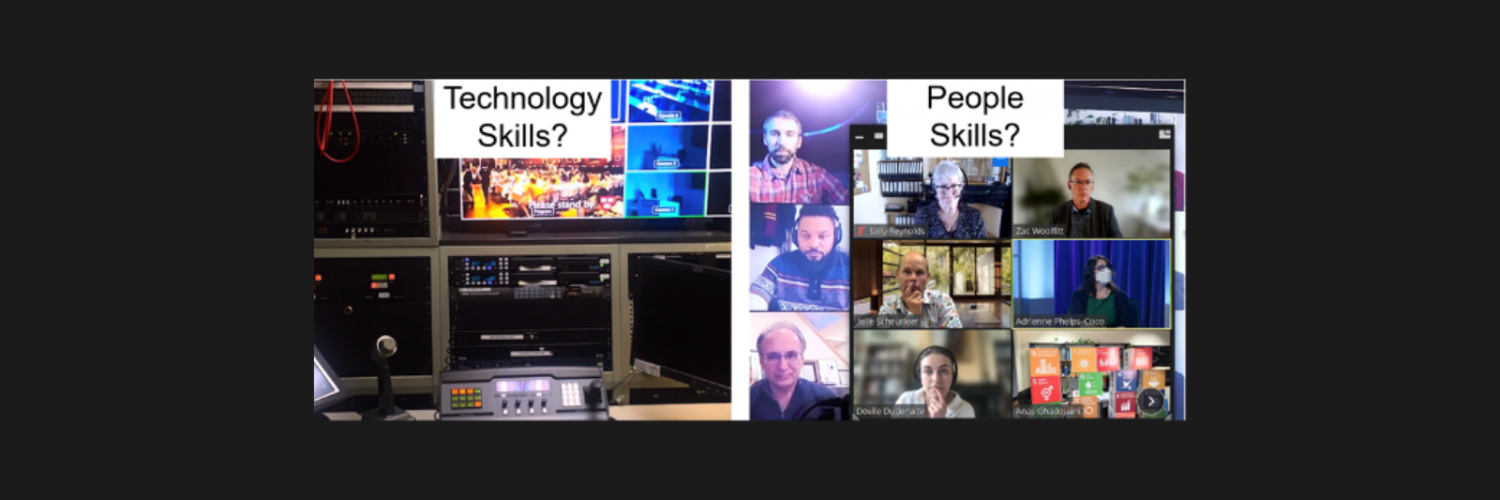By Zac Woolfitt, Inholland University, The Netherlands.
On May 12, Media and Learning connected the globe in their webinar to share good practices about teaching in the hybrid virtual classroom (HVC). Speakers joined live from Australia, the Netherlands and America. And participants joined us online from other international locations. I acted as moderator to the discussion.
The Hybrid Virtual Classroom is ‘designed to connect both onsite students and remote students during synchronous teaching.’ In an ideal situation, the educational experience should be qualitatively equivalent for both student groups and all students and teachers should be able to interact, see, hear each other. Media and Learning had previously run a webinar on the technical set-up of these classrooms. The current webinar focused on how to teach effectively in the HVC..
Before the pandemic, innovative practitioners were already synchronously teaching face to face and online students. After the pandemic, when we returned to semi-locked-down classrooms, this option appeared to be a practical solution to classroom restrictions. Students could choose to attend in person or online. But the realities of teaching in this context turned out to be more complicated than at first sight. The teacher needs adequate technical and pedagogical support. And not all lesson formats translate well in this context.
Students are always right. Students know better.
Anas Ghadouani is a Professor and Program Chair for Environmental Engineering at the University of Western Australia in Perth. His approach to teaching in a hybrid context is to start by engaging his students both online and in the class. He is a bundle of energy, stands in front of the camera with ‘slides’, has stacked cubes of the Sustainable Development Goals as his backdrop and grabs improvised props to make his point. He is very comfortable in front of a camera and easy to listen to, with the knowledge that his approach works.

No PowerPoints, but low fidelity props, simple messages and loads of connecting enthusiasm.
During the pandemic, Anas was concerned that moving everything online would be the death of interaction and active learning. That offering hybrid options for students might mean that students stayed at home, for convenience or ‘because the surf is better’. He brought a psychologist in at the start of each lesson, to make sure that the five-minute ‘check-in’ was managed properly, to create a sense of safety between the student groups. To allow for awkward discussions in a safe context. And this proved very valuable. He also invited students to ‘bring your pet to class’ and they had a ‘silly hat’ day.
The subject of wastewater engineering (dirty water) may not be everyone’s cup of tea. But good teaching can bring any subject to life. His philosophy is that ‘Students are always right. Students know better.’ Each course begins by asking every student what they want to learn and why they want to learn it. These ideas are collected online and in class and become a public contract between him and his 70 students. He promises to do his best to ensure the students get to learn what they have chosen. This public declaration is part of community building. In his classroom set-up, he can easily combine the discussion in person and online. Focusing on subjects that connect the students’ interests. He has got rid of all exams. Instead, they work with assessments. He suggests that ‘maybe we don’t know our students very well. We say they have short attention and can’t focus but is that really so?’ He challenges his colleagues to simplify a complex message into a 30-second TikTok. ‘See, you don’t really need 50 slides to tell your story’.
Teachers should find what makes students curious and help them discover what gets them excited. On location, he creates 30 second teaser videos on his phone and shares this via Instagram, LinkedIn, and Twitter so that everyone can see the subject for the next week. This actively connects the classroom(s) and creates a sense of community. And challenges students to think together.
Online teaching is just face-to-face teaching via a screen
Anas considers online teaching to be face-of-face, but via a screen. By emptying the screen of slides there is more room for engagement and communication. ‘I went analogue, I don’t do slides.’ He finds ways to get students to connect the dots between the various subjects they study each day. We should tell more stories in our education because this is what we all remember. And have more fun. When teachers ‘unlearn’ certain things it creates new teaching opportunities. He suggests we should unlearn the idea ‘that learning has to be tense and serious’.
Having good audio and video is of course essential. But more important is creating a safe and trusting community of motivated and engaged students. Letting each student know you see them as an individual and helping them reach their goals. This approach has enabled him to teach effectively in the hybrid context.
His closing question: ‘How can we have fun and ensure that learning brings joy?’
‘We do not teach. Students bring in their own expertise’
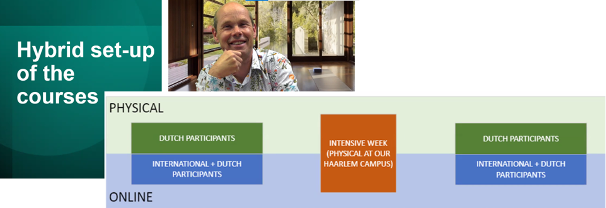
Jelle Scheurleer is Senior Lecturer in Medical Imaging and Radiotherapy at Inholland University of Applied Sciences. As direct colleagues, I’ve known Jelle for several years. He is consistently at the forefront of educational innovation. As course director for post-graduate courses in radiotherapy he started running combined face-to-face and online sessions in 2016, well before the pandemic. He structures his courses to reflect daily professional practice as much as possible.
‘We do not teach. Students bring in their own expertise.’ His focus is to create a positive atmosphere, in which students are active, and the lecturers have the role of moderators, facilitating and enabling the learning to take place. The course has international students, and many students are working. They limit the number of in-person sessions but try to get all students to be together at least once per semester. One reason to combine his course was due to low enrolment size of the Dutch students. With only 5 students in a course, there is limited diversity, and less opportunity to learn from each other. On an average course he may have 5-10 students in the Netherlands and combines them with about 20 international students located abroad.
The first course was piloted in 2016. Jelle agreed with Anas, that successful teaching in this context is all about ‘connection’. He puts a lot of focus on having a very clear and complete ‘welcome meeting’ when the course begins. The starting point is to ‘put students in charge’. They must be active’. Therefore, they need to be able to see and hear each other in the ‘collaborative classroom’. Teachers must not forget what is happening in the other space (online). Usually, two teachers are present acting as moderators. The first is in the physical classroom. The second in the online environment which improves their understanding of the online student perspective and helps communication.
Which learning activities work best in a hybrid classroom?
During these sessions, the student must be active, not the lecturer. Suitable learning activities for the plenary session are students presenting the results of an assessment, a debate, an expert interview, or a case discussion. When moving to break-out rooms (in person or online) suitable learning activities are; documented problem solution, making a pro and con grid, collaborative based and scenario-based learning. There is no ‘sending of information’ during a class. Content is delivered asynchronously.
From a technical perspective, it is essential that students have access to a stable internet connection with sufficient bandwidth. He highlighted some final points. Ensure technical issues don’t distract the goal of the meeting. Keep all the students on-board (particularly online participants), the flipped classroom approach works well in a hybrid course, two moderators are preferred when possible, and keep the meetings short with scheduled breaks and energisers to keep everyone focused.
Are technology or people skills more important in a hybrid setting?
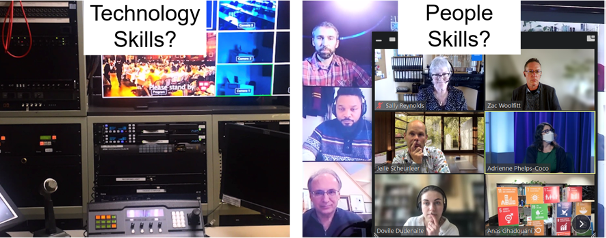
Adrienne Phelps-Coco is the executive director of teaching and learning at the Harvard Division of Continuing Education. She oversees pedagogical and technical support for more than 1,500 online, blended and HyFlex courses each year. Their focus is to build community with their students, in-person, live-online or through asynchronous interactions. Adrienne presented (early in the morning, thank you!) from the Harvard studio. Supported by two colleagues.
The Harvard Division of Open Education has been online since 1997. It is available for anyone in the world to take a degree course. This level playing field was created to ensure that student’s previous academic results were not leading. Their educational concept has been Hybrid from the start. Lectures on campus are recorded and made available online so students can choose how to participate. A recurring challenge is to keep education flexible. To allow the course to evolve during the semester, as the world changes. They have moved away from a ‘fully designed course’ to one that can be modified throughout the semester.
Adrienne asked the webinar public a question: ‘Are people skills or technology skills more important when teaching in a hybrid classroom?’ Although she admits we need both, 94% of respondents chose people skills. You should begin by creating a strong sense of Community by intentionally spending time on this from Day 1. Talk to all of your different groups of students and get them participating.
All that tech can be scary
Entering a hybrid virtual classroom can sometimes be intimidating. All those screens, microphones and cameras. At the start of each course, they take time to give technology explanations to students. Then to help students understand what their experience on the course will be like. As an instructor you need to really understand what your students are experiencing and see it from their perspective.
The design of the teaching room is carefully thought out. They place the camera above the student monitor at the back of room. The eyeline is very important. This means when talking to students online, the teacher looks directly at them (on the screen) and does not have think about where the camera is. When recording in a studio, a teleprompter helps the teacher look into the camera. Ensure that you show empathy to your class and consider how the different groups of students experience the class. Instead of focusing on technology, focus on your students’ experience and how you might reach them.
During her classroom sessions, Adrienne sets her group up in a circle. The students online are on a screen, but the screen is ‘part of’ the circle. And so is the videographer who films the session. This creates equality amongst all groups. ‘We are all in this together’, a community where all groups are welcome.
It is expensive to add technology to a room and then keep remodelling it due to class size. Flexibility is key. They have a ‘portable unit’ that they can take to different classrooms. They put it on a cart and wheel around. You can read about how they set up the HELIX portable classroom here.
Adrienne prepares classes for three audiences. 1 – Those in the classroom, 2 – Those participating synchronously online, and 3 – Those who view the recording asynchronously. Each audience needs to be addressed specifically. Learning activities planned for them in advance. To succeed in teaching in this format, it is important to say hello to every group of students, every week. In the room, to those online, and also to those watching the recording later. This signals that the teacher ‘sees’ them and remembers them. Setting clear expectations at the beginning of the course is essential and getting everyone to participate from the first moment is crucial.
Be consistent in your structure which helps create habits and use the LMS to create a predictable rhythm. Create a clear plan for interaction that works most of the time and replicate it week after week. Tweak it only when necessary. Be inclusive by ensuring all groups of students know their work is seen and feel included in the course community. Adrienne uses a Padlet for each separate student group. She actively returns to posted student content during wrap ups and at the start of new sessions. This can be in a short message recorded before the class starts. It mentions what work was seen, and an invitation to talk about it more during the next session. Students need to know their hard work is being ‘seen’.
‘If you lecture, students won’t show up’
Be consistent by creating a clear plan for interaction that works most of the time and replicate it week after week. Tweak it only when necessary. Learning activities should focus on discussion. ‘If you lecture, students won’t show up’. Teaching in this context can be challenging for faculty, so they appreciate having notes of encouragement from the technology support and teaching assistants.
Ultimately, it is the connection, the human element. Creating ‘a circle of learning that is continually moving!’
Webinar Q&A
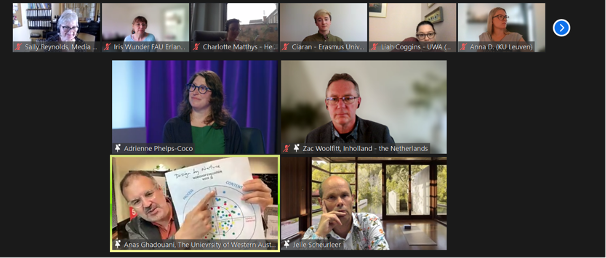
There was plenty to talk about in the Q&A
Think about one person at a time when interacting with students. Experiment to find the best way for you to teach online. Consider using transcriptions for non native speakers. Create a safe and friendly atmosphere.
In order to create community, it is important that students are visible. It remains a challenge for faculty to get students to ‘turn their camera on’. All three agreed this must be an essential discussion point from the very beginning. By actively creating the community this increases the participation via camera. See my article here and an article suggested during the seminar by participant Iris Wunder.
What was interesting about the three different presenters was that they all began by focusing on the importance of using the synchronous time for discussion and interaction, for creating community, and ensuring that all students feel ‘seen’ at an individual level,
By reflecting on how to teach effectively in a Hybrid Virtual Classroom, the three panellists described the core qualities of good teaching. Perhaps these ideas could be a good reminder for all of us teaching in a regular classroom!
Inflated expectations, disillusionment, or enlightenment?
What’s next for the Hybrid Virtual Classroom? Recently, after an online tour of four hybrid virtual classrooms, I wrote ‘The future is bright, the future is hybrid’. Was I being too optimistic?
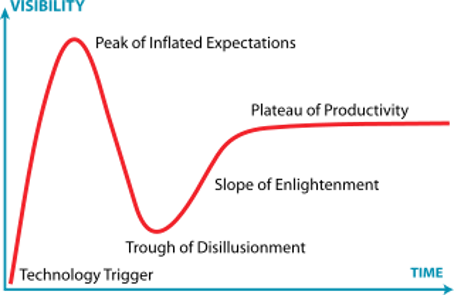
Where would you place the HVC when looking at the Gartner Hype Cycle? My take is as follows. Just after the pandemic, we were at the peak of inflated expectations. The HVC appeared to be a magical solution to scheduling and teaching challenges. Teachers and students quickly found out that doing this well was much more complicated than appeared. We plummeted into the trough of disillusionment. And some higher education organisations have recently made the decision not to use this format at all in the future.
However, I would argue we are nearing the slope of enlightenment. We have learned what does and does not work and are gaining experience. The HVC has some strong elements. An active discussion that connects students in the classroom, with a geographically dispersed group of students or experts who may not be able to join in person, certainly has value. Evening ‘News Programmes’, such as BBC’s Newsnight, have been using this format for many years with panel discussions. But it is a teaching format that should be carefully considered in advance, and not used simply because it is possible.
From ‘Sage on the Stage’ to ‘Moderator in the Middle’
This demands an evolved role for the lecturer. Turning from ‘Sage on the Stage’ (not to ‘Guide on the Side’) but to ‘Moderator in the Middle’. Facilitating and engaging the learning. When will we reach the ‘Plateau of Productivity’? I’m not sure.
The Horizon Report 2022 has many references to ‘hybrid’ education.
‘As institutional leaders plan for enhanced resources and infrastructure in support of new hybrid and online programs and course offerings, they will need to focus on developing sound hybrid and online pedagogies and investing in additional staff and services in the areas of instructional design and faculty development.’
We’ve certainly learned enough recently to know when and how we should be teaching in the hybrid virtual classroom. Based on the discussions during this webinar, once all of the points above are taken care of, there is one common factor that will make or break the hybrid classroom: actively creating an open and positive sense of community within the class.
Many thanks to our guests. Anas who joined us at 8pm his time, Jelle from the Netherlands and Adrienne and her studio crew who were online at 7am! Much appreciated.
For questions, comments, suggestions – please contact zac.woolfitt@inholland.nl

Author
Zac Woolfitt is a lecturer and researcher, Inholland University, The Netherlands.

